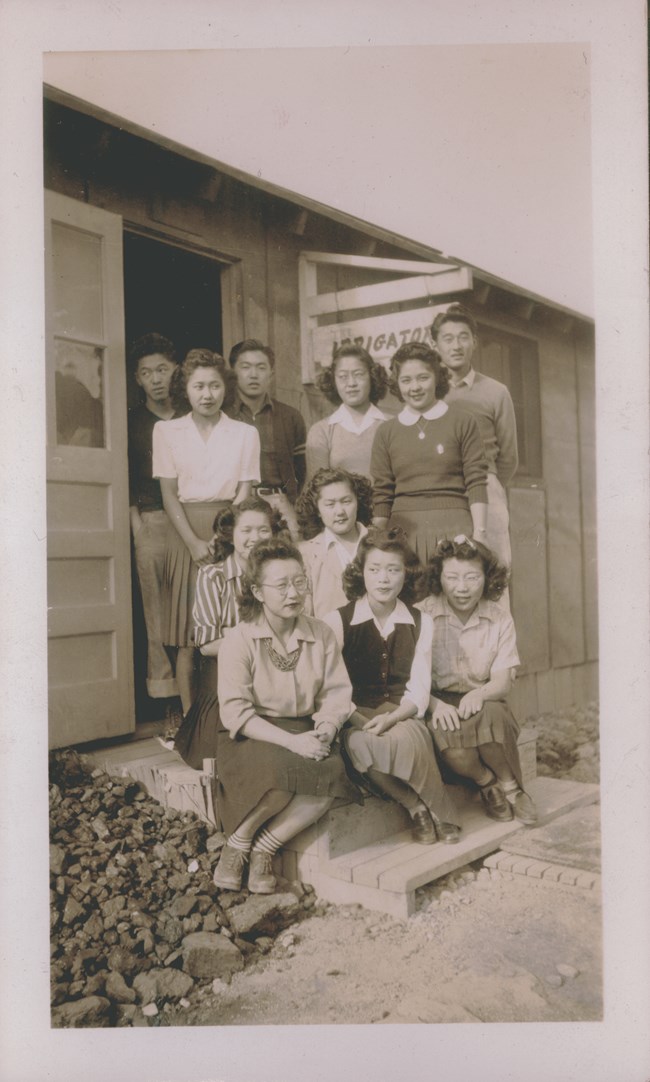Part of a series of articles titled Women's History in the Pacific West - Columbia-Pacific Northwest Collection.
Previous: Julie A. Meachen
Next: Agnes Baker-Pilgrim
Article

Courtesy of Japanese American Museum of Oregon.
Journalist and activist Kimiko “Kimi” Tambara was born in 1919, in Washington state to Seichiro and Kino Tambara, both of whom were first-generation Japanese immigrants.1 The Tambara family was incarcerated at the Minidoka War Relocation Center during World War II, where she became a reporter, documenting the hardships that her community experienced. In a 1980 presentation, Tambara said that her late father hoped that “America would realize that it had treated a segment of its population in a most shabby fashion.”2 She worked throughout her life to urge the United States to reckon with that legacy of wartime incarceration.
Tambara grew up in Gresham, Oregon, where her parents worked as gardeners. At Gresham High School, Tambara acted in the theater department and won awards as a member of the forensics team.3 She attended Albany College (now Lewis and Clark College) where she took a journalism class that inspired her career as a writer and editor.4
On February 19, 1942, President Roosevelt signed Executive Order 9066, authorizing the removal of Japanese Americans from the West Coast. Tambara and her family were given a week to pack their belongings before they were forcibly removed to the Portland Assembly Center, formally known as the Pacific International Livestock and Exposition Center, and then, in September 1942, to Minidoka. The 23-year-old Tambara, like many other incarcerees, determined that “the only way to survive was to recreate the world in a somewhat familiar fashion” to the one she had known before the war.5 For many, this meant joining bowling leagues, holding dances, and competing in beauty pageants. Tambara sought employment at the camp newspaper.
The Minidoka Irrigator was run by incarcerees under the supervision of the War Relocation Authority (WRA), which intended the newspaper to serve as a way to communicate necessary information to people incarcerated in the camp and to maintain morale.6 Tambara began working for the paper a month after her arrival at the camp and nine months later was promoted to editor of the English language portion of the paper. As an editor, Tambara worked especially closely with two young female reporters Cherry Tanaka and Mitsu Yasuda. Other reporters affectionately called the three women the Triumvirate.7 Tambara endured her fair share of conflict with the Reports Officer from the WRA who served as a censor for the paper.8 In one incident, the Reports Officer rejected a lead story by Tambara about the revocation of the Salem Anti-Alien Land Law on the grounds that her writing might not be accepted by white audiences who might come across the Irrigator. Tambara claimed that, even decades later, she was unable to discern why any portion of the article was controversial. During this episode, the vehicle Tambara used to travel to the printer was also searched by the WRA multiple times.9
Tambara is perhaps best known for a letter she published in the 1942 Christmas issue of the Irrigator addressed to her friend “Jan,” who was not incarcerated. In the letter, Tambara recalled walking through Portland’s Chinatown with Jan in 1941, after the bombing of Pearl Harbor. She wrote that a low voice cut through the holiday atmosphere to shout slurs at her and Jan, sending “a cold shiver” up her spine. A year later, in Minidoka, she stated, “I can now understand how an eagle feels when his wings are clipped and caged.”10 On September 17, 1945, Tambara and her family were released from Minidoka. She published one last article that month wishing good riddance to the barracks saying that although the experience of incarceration may seem “best forgotten, to many of us it will remain an interlude, a period in which all of America was also on trial, and lessons learned will never be forgotten.”11
After the war, the Tambaras moved to Portland and started over. Her family ran and lived in a hotel within Portland’s shrunken Japantown, while Tambara worked as a beautician to bring in additional income. She also helped restart the Japanese American newspaper Oshu Nippo (Oregon Daily News), which the FBI had shut down during the war. She was a founding member of the Portland chapter of the Japanese American Citizens League (JACL) and was elected president of the chapter within a year.12 While at the JACL, she fought for the US government to apologize and provide redress to Japanese Americans for their wartime losses. In her later years, Tambara was a member of the Japanese Ancestral Society of Portland and the Nichiren Buddhist Church. She used these connections to advocate for the development of housing for the elderly. In the last three years of her life, she edited the English section of a bilingual newsletter for Japanese Americans titled The Community News.13 She died in 1982.
“Do Words Matter? Euphemistic Terminology.” Do Words Matter? | Densho Encyclopedia. Accessed August 31, 2020. https://encyclopedia.densho.org/terminology/.
Part of a series of articles titled Women's History in the Pacific West - Columbia-Pacific Northwest Collection.
Previous: Julie A. Meachen
Next: Agnes Baker-Pilgrim
Last updated: February 22, 2022